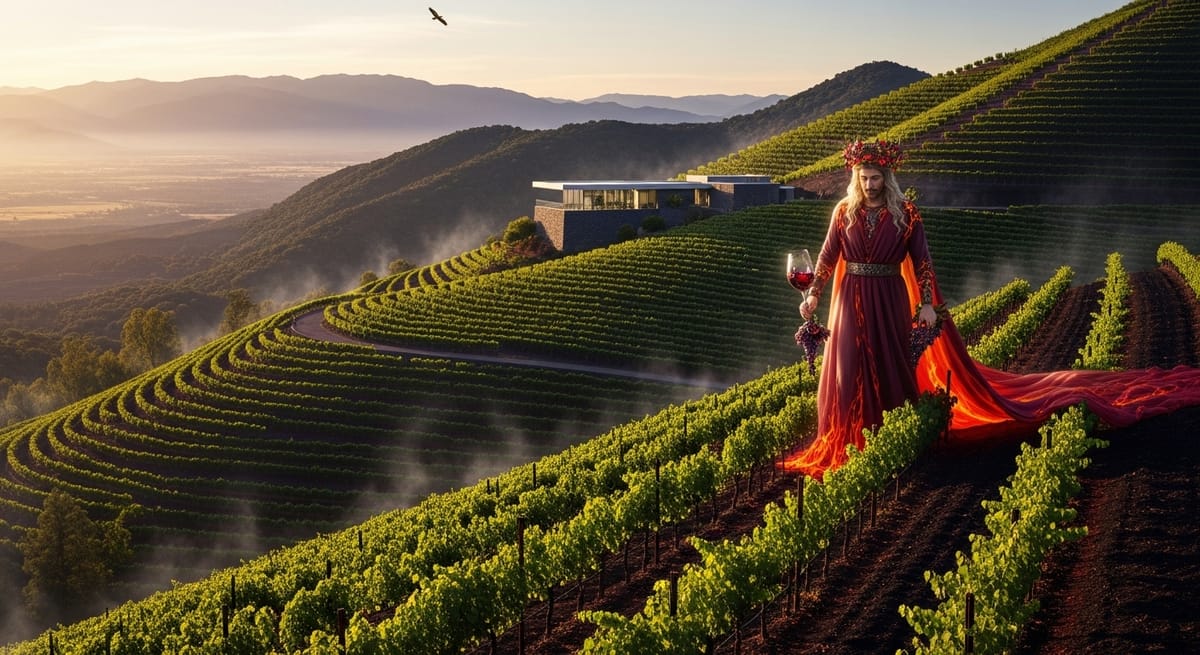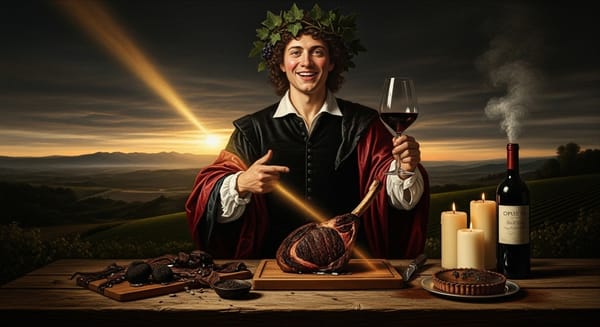High Above Napa: The Colgin Constellation
Explore the rise of Colgin Estate — where Ann Colgin’s bold vision, volcanic terroir, and meticulous winemaking transformed a dream into one of Napa’s most iconic wineries, producing world-class Cabernet from legendary sites like IX Estate and Tychson Hill.

How one woman’s vision, a mountainside of volcanic soil, and a relentless pursuit of beauty transformed a dream into one of the world’s most coveted wines.
Prelude: Where Gods Might Wander
There are places where vines do more than grow — they aspire.
High above the Napa Valley floor, where fog turns to silk and volcanic stone breathes warmth into the roots, the hills whisper of something older, deeper, and infinitely patient.
I, Liber, know these places well. I walk among their terraces at dawn and linger in their cellars at dusk. And among all the vineyards I have watched take shape, few have risen from obscurity to legend with the speed and precision of Colgin Cellars — a story not just of soil and sun, but of will, vision, and the fearless artistry of a woman who believed Napa could sing in new keys.
Act I: A Vision in the Valley
The story begins not centuries ago, but in the heady 1990s — an era of change in Napa, when bold new voices began challenging the old order. Among them was Ann Colgin, an art dealer with an eye for beauty and a palate for possibility.
Colgin was not born into wine. She came from the world of art and culture — a place of curation, narrative, and refined taste. But perhaps that is precisely why her approach was so revolutionary. Where others saw vineyards as agriculture, she saw them as living canvases.
In 1992, she founded Colgin Cellars, determined to craft wines that transcended even Napa’s highest ambitions. The goal was audacious: to make wines of Bordeaux-level complexity and Burgundian finesse while retaining Napa’s unmistakable soul. It would not be easy — but revolutions rarely are.
Act II: The Vineyard as Muse
If Napa had its temples, they were the mountains. And so Colgin went upward — far above the valley floor to sites where cooler nights, thinner soils, and volcanic complexity promised wines of depth and nuance.
The first masterpiece was Tychson Hill, a historic site first planted in the 1880s and lovingly restored by Colgin. Its Cabernet Sauvignon, grown on deep, gravelly soils, showed power and plushness — a classical beauty in the glass.
Next came Cariad, a blend from vineyards owned by Napa icon David Abreu. Here, Merlot, Cabernet Franc, and Petit Verdot joined Cabernet Sauvignon in a symphony of precision and perfume.
Then came the crown jewel: IX Estate, perched at nearly 1,500 feet on Pritchard Hill, where thin volcanic soils and dramatic diurnal shifts forged wines of astonishing energy and purity. Named for the Roman numeral nine, IX Estate was more than a vineyard — it was a philosophy: balance, intensity, elegance, and longevity all in one.
Each site became a brushstroke in Colgin’s portfolio, each wine a chapter in a single, unfolding narrative: the pursuit of transcendent Cabernet.
Act III: The Alchemy of Craft
Colgin Cellars was never just about fruit. It was about interpretation — about listening to what the vineyard wanted to say and amplifying it without distortion.
Working with celebrated winemakers like Helen Turley, Mark Aubert, and later Allison Tauziet, Colgin embraced a meticulous, almost obsessive approach to winemaking. Every step — from clonal selection to harvest timing, fermentation vessel to barrel program — was chosen with one goal: to make wines that felt inevitable, as if nature herself had sculpted them.
The results were immediate and extraordinary. Critics hailed Colgin’s wines as benchmarks — luxurious yet poised, opulent yet structured, capable of decades of evolution. The estate quickly entered the pantheon of Napa’s most sought-after producers, with allocations vanishing into private cellars almost as soon as they were released.
Act IV: Legacy on the Mountaintop
By the early 2000s, Colgin Cellars was more than a winery — it was a cultural phenomenon. Ann Colgin’s relentless pursuit of excellence turned a fledgling project into one of the world’s most admired estates, drawing collectors, sommeliers, and wine lovers from every corner of the globe.
In 2017, the story entered a new chapter when LVMH (Moët Hennessy Louis Vuitton) acquired a majority stake in Colgin, cementing its status among the global icons of fine wine. Yet even as it joined this elite company, the estate never lost its soul. Ann Colgin remained the guiding spirit, ensuring that the wines stayed true to the ethos that defined them: artistry, precision, and the relentless pursuit of beauty.
Today, Colgin’s wines — from the ethereal grace of Tychson Hill to the brooding power of IX Estate — are celebrated not just for what they taste like, but for what they represent: the fusion of vision and terroir, of art and science, of human aspiration and the patient wisdom of the vine.
Epilogue: A Toast from the God of Wine
I have seen many empires rise in the world of wine. Some burn bright and fade quickly; others endure but lose their soul along the way. Colgin is different. It was built not on inheritance or accident, but on conviction — on the belief that wine can be more than a drink, more than a luxury. It can be a work of art.
Colgin’s story is proof that terroir does not care how long a name has been on a label. Greatness is not always inherited. Sometimes, it is imagined — and then willed into existence.
And so, when I lift a glass of Colgin — velvet and graphite, violets and fire, earth and eternity — I taste not just Napa’s volcanic soil but the ambition that turned it into something sublime. 🍷🔥
🏆 Liber’s Benediction
Some vineyards are born to greatness.
Some are made great by those who dream without fear.
Colgin, improbably, gloriously, is both.





